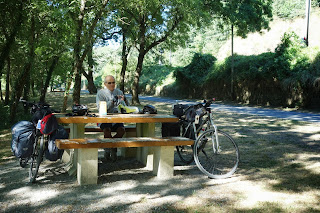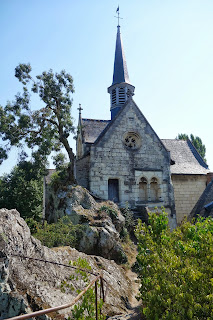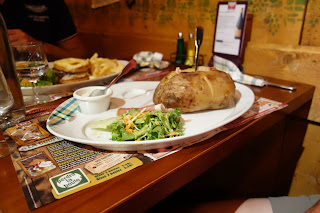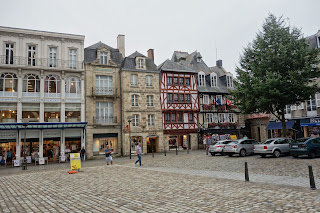2nd - 6th September
The train trip on the TER was very quick at 50 minutes and only one stop and we went straight out of Nantes, though it would have been quicker if we had known to take the south entrance to exit for the Loire cycle track. Signage for the Loire à Vélo starts about 2 kilometres after I would like it to.

We easily reached the camping ground we had worked out - but couldn't quite believe how long the queue took to clear - more than 30 minutes for maybe 5 people! It is a lovely camping ground about 7km out of Nantes, with a very large area for walkers and bikers- no cars allowed, tables to sit at, and close to facilities. Belle Rivière at St Luce. The people running it offer a complimentary drink and aperitif snacks to cyclists and we were also able to buy some bread and pâté to complement the fruit and veges we had got from the growers en route. Fairly unheard of at that hour of the day. A good selection of local beer and Breton cider made our day. Oh, and toilet paper. Those of you who have travelled in camping grounds here will appreciate this bonus!
 |
| Floods! |

 Next morning we got away easily, having been able to satisfy our yearning for coffee and croissants right there in the camping ground. We stopped for photos and an early lunch, yesterday's leftovers, only to find we had to wait until 2pm for the castle (at Oudon) to open. What else can one do other than find a bar and pass the time? The bar we found - to have our coffees in - please note coffee and don't ask about the patisseries we had with it) - had two NZers from Queenstown - on day 2 of their tandem ride along the Loire, so there was heaps to talk about!
Next morning we got away easily, having been able to satisfy our yearning for coffee and croissants right there in the camping ground. We stopped for photos and an early lunch, yesterday's leftovers, only to find we had to wait until 2pm for the castle (at Oudon) to open. What else can one do other than find a bar and pass the time? The bar we found - to have our coffees in - please note coffee and don't ask about the patisseries we had with it) - had two NZers from Queenstown - on day 2 of their tandem ride along the Loire, so there was heaps to talk about!Oudon is one of the many castles on the borders of Brittany, a strategic location In medieval times. Although it is built like a fortress, it was also the main home of the seigneur, and has common rooms, bedrooms, kitchen, fireplaces, window seats, toilets, good windows for lighting. They also fitted rooms into the thickness of the walls - wardrobes, guardrooms and a back staircase. Each floor has been set up with an audio-visual and/or interactive exhibition to illustrate some aspect of the castle or the Loire - you move through it at your leisure. The tour of the castle took over an hour and it was after 3.30 before we left there, making it to the Ancenis camping ground by 4.30. This is one of the fancy ones, with a swimming pool and it looked so inviting I actually had a swim!

We had a look around Ancenis the following morning, another Gateway to Brittany, though the castle was closed for renovation. It was a very prosperous town in its heyday and much of the money was invested in housing. There are some really lovely houses from wealthy wine traders and such, dating from the 16th to 19th centuries. One of the 15th century houses is now the Maison des Vins, where wines from the region can be tasted. No doubt bought as well! Wasn't open when we went past.
It took a while to find a bar where we could get ourselves some coffee and they didn't sell croissants - the plus for this is that if they don't sell them they don't mind you going to the bakery to get your own. The guy told me where I would find some. In the end I bought pains au raisin because they looked so good - and were. This is the place where I resisted some fantastic looking glasses (verrines) of various mousses with layered toppings, merely because it was too early in the day. I probably won't make that mistake again. They still haunt me! On the other hand, I asked her to box me up a chocolate tart so that we could have it later. That was an excellent decision, as between the pastry and the chocolate was an extra layer of something crunchy-possibly hazelnuts. Very yummy.
At St-Florent-le-Vieil we stopped to visit a a former abbey. It was quite a push to get up there but the view was splendid. Another casualty to the Normans and later the revolution and the Vendée wars. Today the church is open - and in behind the former abbey gates, on a Wednesday afternoon, locals gather to play local bowls - Angevin style, with large wooden (now plastic) bowls, on a smallish court, in what appeared to be a very aggressive style ( anyone for croquet?). The bowls are a lot like English bowls, with a bias, and are typically played on a smooth surface, but not at the abbey, anyway.
 |
| One of the levées |
 |
| Montjean |
Suddenly, there you are, with the great castle before you, and you are in Angers. The piste cyclable takes you right up past the castle and almost into the tourist information centre-which was lucky for us, as the small hotel I wanted to go to, where I have stayed twice before, was full because the festival was due to start. Luckily the tourist office found us another one close by and we were very happy with our accommodation. With the festival about to start, we checked the program - all free - and decided we'd stay the next day as well!
There was a lot of music on offer and we wandered around the river bank taking in the shows - Jeff Zima (USA) with the Blues - New Orleans style, some acrobatic young men using a seesaw and a cushion pad to do summersaults and twists with a bit of humour, and Raggalendo, 4 (girl) cousins, singing in a Breton accent, wearing traditional coiffes, with a mixture of rap and hip-hop that has a Breton feel to it. "Bringing the feel of the Breton culture of their grandmother into the 21st century." They were very popular and we watched them for a long time. In the evening we went out to a very modern play, Far West 2037, which deals with survival, really. It involved the audience moving around to be able to see more of the action from different angles, and had large props moving around the space. Interesting and enjoyable.
 |
| Behuard |
 |
| Behuard |
For the record, we also took the tour of Angers by le petit train (the little train), something we hadn't done last time we were there. It was a fun trip, and we were glad to have spent the time that way. We'd already done the essential last time in Angers - the castle with its fabulous tapestry of the Apocalypse (14th century).










































